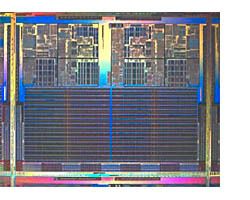AMD reveals first details about dual-core Athlon 64
Sunnyvale (CA) - Intel will demo a complete lineup of dual-core processors at its developer forum next week. To keep up the pace, AMD today revealed first details of its first desktop dual-core chip, which is expected by mid-year. The company may be second with the introduction of a desktop chip, but there is no doubt AMD will be breathing down Intel's neck with a capable processor.
The announcement offered little details in specs and leaves more room for speculation of the final processor, how it will stack up against the single-core Athlon 64 and Intel's Smithfield dual-core Pentium chip. So far, AMD limits its details to 1024 kByte of L2 cache for each CPU for a total of 2 MByte. The processor, code-named "Toledo", will be built in 90 nm, integrate 205 million transistors as well as a shared Northbridge with single HyperTransport link and Dual-channel 128-bit DDR memory interface.
As Intel, AMD also bets on existing infrastructures to simplify the transition to the dual-core chip. However, while Intel will couple Smithfield with the 945 chipset and the 955X for the Extreme Edition dual-core, AMD's Toledo runs with the existing 939 chipset and remains in the same power envelope (110 watts) as the current single-core Athlon 64: AMD users, who want to run the processor, only have to switch the single-core for dual core chip and apply a BIOS update.
In contrast to Intel, AMD will introduce dual-core server and workstation processors first and follow then with desktop versions. Tina Brown, branding manager at AMD, said the company believes servers and workstations to be the first systems to take advantage of dual-core processors. "Users in these environments are already familiar with 2P or 4P servers and workstations. Multithreaded applications are also common especially in this environment."
Other than its competitor, AMD does not position the dual-core chip as the best-performing processor of its product line. At least for one more upgrade, the single-core Athlon FX will remain the choice for gamers in the firm's portfolio. "There is still lots of scalability in this chip that will allow it to keep a performance lead," said Brown. As long as games would be single-threaded, there was no need for AMD to offer a dual-core version of the chip, she added.
The announcement put little emphasis on the performance capability of the chip. Instead, AMD stressed a "least disruptive transition" for users and a "cool and quite" operation of the chip. The company mentioned in the past, that the performance could increase within certain applications by 30 to 55 percent compared to a single-core chip. Brown was more conservative saying that Toledo will meet the "user's performance expectations in terms of productivity."

According to industry sources, Smithfield is rated at a maximum power consumption of 130 watts, compared to 110 watts of Toledo. If AMD is able to scale Toledo beyond 2.4 GHz, Intel could end up in an uncomfortable position, the sources said.
Stay on the Cutting Edge
Join the experts who read Tom's Hardware for the inside track on enthusiast PC tech news — and have for over 25 years. We'll send breaking news and in-depth reviews of CPUs, GPUs, AI, maker hardware and more straight to your inbox.
It is still too early to judge which company has the right dual-core strategy. Kay hesitated to praise one or the other firm's approach, but agreed that the success of dual-cores will come with the availability of multi-threaded applications that allow multitasking.
Related stories:
AMD: Dual-core tech accelerates Opteron by more than 30 percent
AMD to keep dual-core processors in current 90nm power envelope
Intel begins dual-core production, announces 945 and 955 chipsets
Intel's dual-core CPUs to set new record high in power consumption
Most Popular


